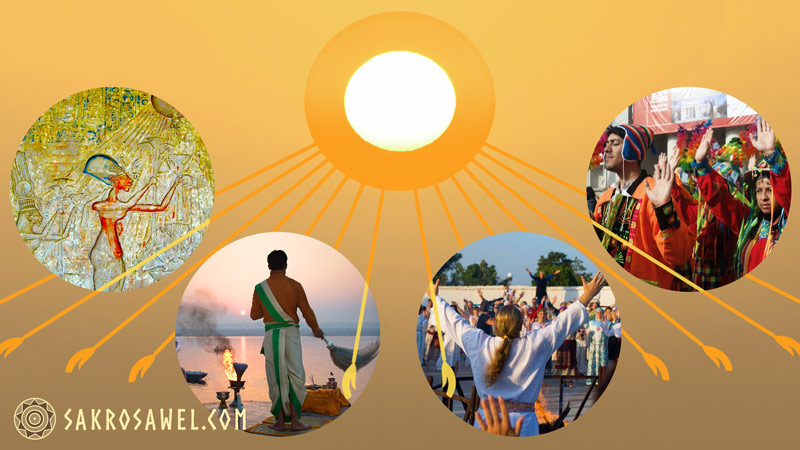
Images: Aten CC BY-SA 3.0 by AtonX, Akhenaton CC BY 2.0 by Jean-Pierre Dalbéra, Aarti CC BY-SA 3.0 by Jorge Royan, Ukraine CC BY 2.0 by Yuri Samson, Inti Raymi CC BY-SA 4.0 by Jisa39
A Brief Overview
To read a full FAQ about the Religion of the Sun, visit the Religion of the Sun website.
What is the Religion of the Sun?
The Religion of the Sun is a religion that was widespread in ancient times in which the sun was venerated as the supreme manifestation of the divine.
It was the most widespread religion in ancient times and one of the most powerful influencers on human history. It had a massive and profound influence on ancient religion (including Christianity) and upon the development of civilization.
Sun worship was common among the civilizations of the ancient world. It was practiced:
- in ancient Egypt
- by the Indo-Europeans, which include:
- the Celts and Druids
- the Vedic practitioners of India
- the Persians
- the Hittites
- the Minoans and Mycenaeans of Greece
- the Germanic and Slavic peoples
- among the megalith builders of Europe
- in Sumer
- by the Phoenicians
- by the mound builders and Pueblo people of North America
- by the Aztec, Maya, and Inca
- and in many other traditions
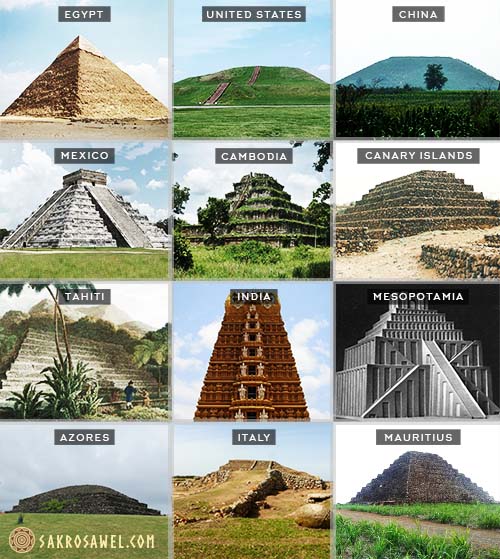
Pyramids of similar design can be found across the world, and almost all of them are associated with the worship of the sun (as some of them have not been studied). Image credits: Egypt CC BY 2.0 by Jerome Bon, United States CC-BY-SA-3.0 by Skubasteve834, China public domain, Mexico CC BY-SA 4.0 by Daniel Schwen, Cambodia public domain, Canary Islands CC BY-SA 3.0 by Pedro ximenez, Tahiti public domain, India CC BY-SA 4.0 by MADHURANTHAKAN JAGADEESAN, Mesopotamia public domain, Azores CC BY-SA 4.0 by Torbenbrinker, Italy CC BY-SA 3.0 by Gianf84 at Italian Wikipedia, Mauritius CC BY-SA 4.0 by Uli sh
By studying their beliefs and history, my husband and I realized that the religion of these ancient cultures was influenced by or derived from a common source. That source was the Religion of the Sun, which was spread to different parts of the world thousands of years ago by a sea-faring civilization we call “the Lost Civilization of the Sun.” This religion is the reason why the same style of megaliths—like pyramids and standings stones that are aligned to the sun—are found across many parts of the world, and why the same or similar symbols (particularly those to do with the sun), legends, cultural artefacts, languages, and beliefs can also be found in all the places it spread.
The term “the Religion of the Sun” was first used by my husband and I (Mark and Lara Atwood) in 2016 to describe this religion, which we discovered and are piecing together through our research.
How old is it?
This religion is at least thousands of years old, but could be tens of thousands of years old or more. For example, both ancient Egyptian and Indo-European traditions describe a distant “golden age” when their solar religions were first practiced. Ancient records kept in Egypt state that Egyptian civilization and religion date back as far as 42,000 years ago, and the archeological evidence of Indo-European sun worship dates as far back as 12,000 years ago. Both Egyptian and Indo-European cultures state that their way of life and religion was a legacy handed down to them from a civilization destroyed by a global catastrophe.
Where did it come from?
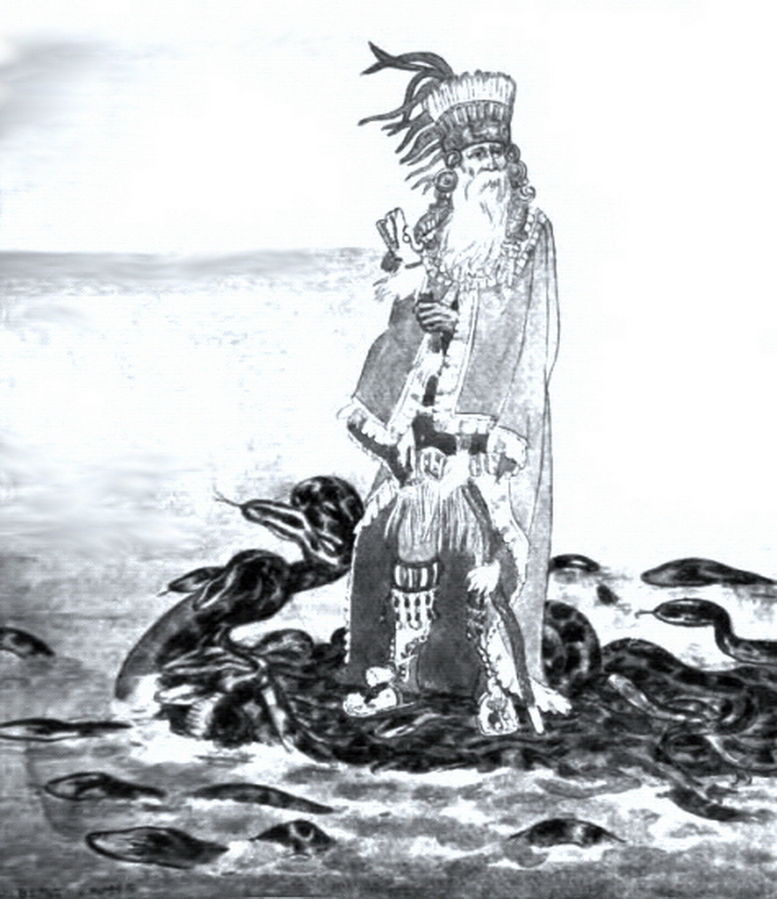
Quetzalcoatl, the wisdom bringer worshiped by the Aztecs of Mexico, who was described as fair-skinned and bearded, and as arrived from across the ocean.
According to numerous ancient legends (including those of a number of indigenous peoples of the Americas), the Religion of the Sun was first practiced among the people of a now lost civilization that was destroyed by a great flood. This flood likely occurred around 9,700 BC, which is the date that coincides with that given for the destruction of the lost civilization of Atlantis by Plato, and the massive rise in temperatures and sea levels that occurred at the end of the last ice age.
The traditions of numerous indigenous peoples in different parts of the world then record how a number of priests/sages, who survived a great flood, came to teach them the arts of civilization and the Religion of the Sun. I refer to these priests/sages as “the wisdom bringers.” Examples include Viracocha of the Inca, Quetzalcoatl of the Aztecs, Masaaw of the Hopi, Manu of India, and Osiris of Egypt. They became worshiped as gods, but the ancient legends about them reveal, they had been real people.
Following this, a global civilization arose which had adopted the Religion of the Sun, and further spread it across the earth – both by land and sea. This civilization appears to have originated from around the region of the Black Sea (the Caucasus and Anatolian region), where the oldest dated megaliths in the world, called Gobekli Tepe, have now been discovered. My husband and I call this culture the Lost Civilization of the Sun.
Although it’s generally believed that ancient people did not have the ability to cross oceans in any significant way before Columbus in 1492, there’s plenty of evidence they did, and that in fact the oceans were busy with migration and trade. Modern expeditions have used reconstructions of ancient ships to prove ancient people could have traversed the oceans, and even solitary rowers have made these ocean crossings in recent times.
Why did they worship the sun?
Most think that sun worship arose out of the instinctual impulse of primitive people to make gods out of those things important to their survival. However, ancient texts clearly describe that the sun was venerated for a much more profound reason, which had to do with the spiritual nature of light. Light was seen as the greatest visible manifestation of the divine. As the sun is the greatest source of light we can see, it was venerated as the outpouring of the divine in the material world, which ultimately had its source in an invisible, supreme creator.
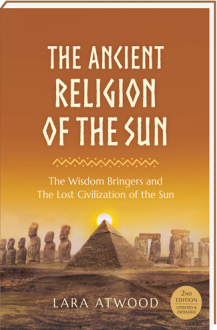
Where can I find out more?
While the evidence for the existence of the Religion of the Sun has remained in scattered remnants left behind in various ancient texts, megalithic sites, and symbols, the actual information of how to practice the religion itself in any coherent and meaningful form had become lost over thousands of years of suppression and persecution.
However, we are working to bring this religion back.
I provide a detailed overview of the ancient Religion of the Sun and its history in my book The Ancient Religion of the Sun. My husband provides an overview of its theology in his book Ancient Solstice, which I helped co-author. I also have a YouTube channel where I present videos about it.
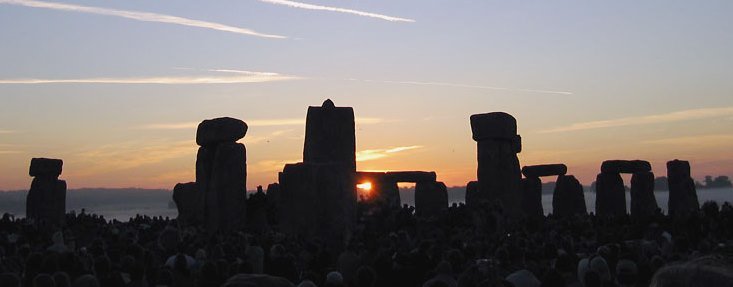
14 to 19 thousand people gathered to watch the summer solstice sunrise at Stonehenge in England in 2005. There is a large and growing return to the ancient remnants of the Religion of the Sun. Photo by Andrew Dunn reproduced under CC BY-SA 2.0
Background
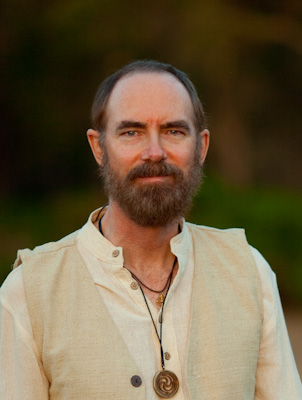
My husband, Mark Atwood
The ancient Religion of the Sun is not something my husband and I set out to find, or heard about from somewhere else. It’s something we discovered unexpectedly.
In 2011, my husband Mark and I began researching the ancient traditions connected with the celebration of the solstices and equinoxes, and releasing web articles explaining their spiritual meaning. We came to realize that a number of ancient people in the distant past had to have understood their deeper meaning at one time, and had sometimes incorporated these meanings into the sacred sites they aligned to the solstices and equinoxes, and into their rituals and celebrations.
We also came to realize that the path of the sun throughout the year actually correlates with the path to self-realization/enlightenment, etc., alluded to in many ancient wisdom traditions. My husband began this path in 1991, which is how he was able to decipher the meaning of so many teachings and symbols of the ancient Religion of the Sun.
In September of 2013 we compiled our web articles on the solstices and equinoxes, and released them as a free eBook (now only available in paperback and titled Ancient Solstice), explaining within it that there had once been a solar religion practiced across many parts of the world in ancient times, which had given rise to the building of many of the world’s most enigmatic sacred sites, like the Great Pyramids of Egypt, the statues of Easter Island, Stonehenge in England, and countless others.
We began referring to this religion as “the Religion of the Sun”—a term we coined ourselves, but later discovered had been used in a handful of instances over the last few centuries, most notably by Thomas Paine, who was one of the founding fathers of the United States and likely a Freemason. Thomas Paine was the only one to employ it as any kind of formal title—using it to describe the religion that had been practiced from the remotest antiquity before spreading over large parts of the ancient world, and later being preserved in Freemasonry. All other uses (of which I have only found a number that can be counted on one hand) were merely passing and one-off, using it as a descriptive phrase for ancient forms of solar religion—mostly in books dating from over seventy years ago.
By this time I had done a massive amount of research by reading scores of ancient texts from numerous traditions (at least over one hundred from cover to cover) and researching the alignments of large numbers of ancient sites from around the world. Out of this, we included hundreds of excerpts from ancient texts as well as images of ancient sites and symbols in our book as supporting evidence.
Initially I had thought that the many different cultures evidenced as practicing the Religion of the Sun in some form had done so independently of one another. In my research, I had come across many similarities between the symbols of ancient cultures (even though they were never meant to have had any contact with one another), and had put this down to people within these ancient cultures coming upon the same spiritual knowledge through mystical experience and encoding it using the same symbols.
The penny dropped only later, in March 2016, when researching ancient sites on the Internet, I stumbled across the website of Martin Doutre of http://celticnz.co.nz/. In his work, Doutré painstakingly analyzes the measurements used in the building and layout of many ancient sites in different parts of the world, and demonstrates that their builders used the same standard measurement system, and thus were part of or influenced by the same global civilization. Although Doutré does not discuss the Religion of the Sun, he does recognize that the builders of these sites venerated the sun. After reading some of his articles, Mark and I realized that the traces of the ancient Religion of the Sun that we had been researching and studying had originated from the same source in remote times, and had once been the religion of a post ice-age global culture and civilization now lost. Mark and I named this civilization “the Lost Civilization of the Sun.”
Months later, Mark and I released an updated edition of our eBook, which was now in paperback, to include a chapter titled ‘The Lost Civilization of the Sun’ in which we shared our findings on this lost civilization. Since then, I’ve read the works of authors such as Thor Heyerdahl, Graham Hancock, Dr David Frawley, and Gordon Kennedy, whose research has confirmed and added detail to what we had first realized in 2016 about the existence of such a lost civilization.
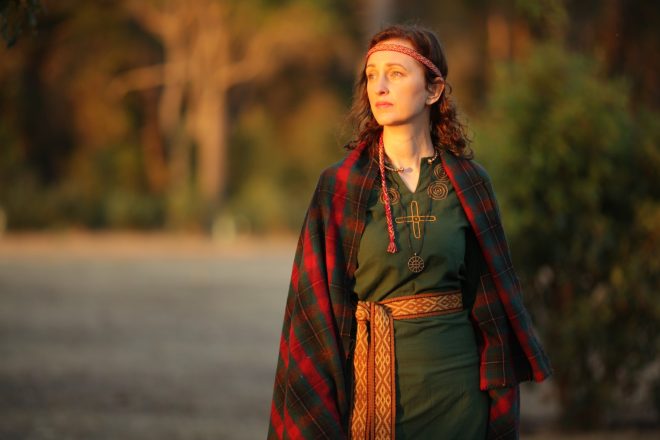
It’s important to mention that our research was a journey—we in no way set out with a destination in mind when we first began writing about the solstice back in June of 2011. We had absolutely no idea what we were in for—we instead simply followed the evidence as it led us from one thing to another. We had no idea that a Religion of the Sun, wisdom bringers, or a Lost Civilization of the Sun had ever existed.
Both of us had been schooled in the mainstream, isolationist view of ancient history, and had never had any reason to question it. That’s why our own discoveries each came as major shocks to us. For me, finding out about the Lost Civilization of the Sun particularly was what I call “a Truman Show moment”—as like in the film, when the character that Jim Carrey plays steps out of the false life he had been born into, I felt everything I had ever been taught and believed about ancient history was essentially a façade that had been constructed over reality, much like a Hollywood movie set. While it was a huge shock to discover this information, I also felt incredibly grateful to have been given the opportunity to step out into a new world that made so much more sense, and which revealed the greatest religion in the world, and one of the most courageous and inspiring spiritual missions of all time.
As far as I’m aware, no one else has come to the same conclusions we have, in the way that we have. Although some researchers whom I greatly admire have pieced together the traces of a lost Ice Age civilization, and brought together a lot of information on the wisdom bringers and the influence they had on various cultures, as well as recognized the solar nature of Indo-European religions, and some of the similarities between sun worship in different cultures, I haven’t seen anyone bring it all together to construct a coherent narrative that traces the origin of this religion as far back as possible, tying it in with the wisdom bringers, the legends of Atlantis, and numerous megalithic sites worldwide, as well as revealing the deeper meaning of its symbols and how to practice it. Essentially, we’ve tried to put together the whole package and tell the whole story of the Religion of the Sun, often spending seven days a week writing and researching for many months at a time, without charging anything, as we deeply care about this message and realize how important it is for people to know.
However, there is a difference between our methods of study and those of purely academic researchers. We not only write about the Religion of the Sun and research its evidence throughout history, but first and foremost, we practice it. Many people think you find out about things just by reading, but there is a limit to how much you can find out by reading alone. Ancient mystics discovered their knowledge through experience—one which is inner/metaphysical. The Religion of the Sun is a body of knowledge and a metaphysical practice that is directed toward the transformation of the individual, and thus someone can only truly uncover and understand its practice through practicing it and transforming themselves.
Someone can essentially have the same metaphysical experiences these ancient peoples did, and can thus penetrate into the true meaning of the symbols and writings they left behind, even when they are currently obscured or misunderstood. Since releasing the Sakro Sawel videos, a number of people have come to my YouTube channel after having an experience with the Being who in Nordic/Germanic tradition became known as Odin and Wotan—to some he appeared in a dream; another he led out of a coma. I have also had the great fortune of meeting this Being in an out-of-body experience. This is the Religion of the Sun at work—it’s a living practice, where the traditions of old are not locked
in the past, but are alive as they once were, when the wisest of our ancestors were in touch with the other worlds, and through its practice, we can be too.
Videos
The following videos I’ve done give an overview of some of the key background information to the Religion of the Sun.
An overview of the ancient Religion of the Sun.

About who the wisdom bringers were.

About the Lost Civilization of the Sun.

Why people venerated the sun.

~ Lara Atwood


Dear Lady, the sun in old human religion represent a mythic light, because when human die, we all go to see that Light,and old traditions know that….. in time before old times before great big mythical change, every person live in harmony with nature and with other, and every soul have connection all time with mythic light, and we all have a telepathy….(one language to we all understood each other), (that language is language what is separated in many human language,to we not understood each other) because ancestors put us in cage of materialisam and we forgot to use that ability…. I speak about a time before ancestors from other dimension come and conquer this quadrat of our milky way….. From that time, we are not a free…. and we live like animals closed in materialistic world. They change us and try to delete our real history…… that is reason why we know only maybe some thousand years of our history…..it is imposible that human being exist how we exist and know only segments of our history in last 2000y. we still debate is Isus real person or fake…..one of deep n.d.e. experiencers
Breathtaking work ,i am inspired grateful and humbled all at once when reading your books.Thankyou both for all your efforts Im sure its a lasting legacy for humanity. Fortunately there is research and investigation at present into our ancient past all over the world ,its becoming evident that the ancients had advanced technology to build the structures for instance many sites have been scientifically analysed to revealed geothermal process to acheve the astounding meticulous nature of the structores the perfect rightangles and honed finishes of the surfaces and as you say the exacting alignments. We are in an age where everything is being revealed and it is surely a result of consciousness being raised to a state where it can be accepted . Thankyou again.
I’ve only just started reading your book “The Ancient Religion of the Sun”, and it’s amazing to see how much research has gone into it. A combination of in-depth research into the Wisdom Bringers of ancient times combined with practical exercises to gain teachings and guidance from other worlds is something truly special.
Yes Cheryl, there are literally tons of evidence around the world that suggest the truth about our past is not like what they tell us to be. Unfortunately the researches into this types of fields have always been categorized by mainstream experts as pseudoscience and pseudo history, with little to no evidence and largely based on subjective assumptions. But these so-called experts have not even put in the slightest effort necessary for them to come to any kind of conclusion on this matter. The mainstream media is so flooded with lies and propagandas that only tell us what they want us to know, and the general public is so brainwashed that they more often than not don’t take the truth seriously even when they have been told about it. This is the world we live in,unfortunately. I have found interesting stuff about Japan on my own which could very well be related to a lost global religion which existed a long time ago. But when I try to talk to people my discoveries they look at me as if I had done something crazy and would not believe in anything I say about this topic.
Haha Emily, I can relate, welcome to the “conspiracy theorists” club. :-) I feel the society today is really twisted mainly due to the control and censorship that exists in the mainstream media, academia, politics, etc. Looks like our history, and even our present is being hijacked by Darkness (via their puppets) that tell people their own version of “truth”, which not only is often diluted and twisted, but often straight dangerous (like whats happening in the medical industry for example). Not even talking about the so-called “entertainment” business. I am finding that its best to just tell people little things here and there, according to what you feel they can handle, and otherwise just talk to your own…
Hi Lucia,I absolutely agree with you. I wouldn’t even call it a “conspiracy theory” though. This is the one unfortunate truth about our world, anyone can come to this conclusion if they could just allow themselves to think a little bit more freely, if you know what I mean. But it’s sad that most people would rather just believe what the media tells them, what they had learned in school, and what the government says, etc. They think because this is what the “authorities” say, therefore the information they received can be trusted. But when they come across things that seem to challenge their worldview, when it makes them question whether the information fed to them could be true, instead of asking the right questions they just pretend they didn’t see the evidence and continue to believe in the false narrative that they have received. I know someone who wanted to speak on a history conference at a university about his findings that would proof Atlantis really existed. He was turned down however due to his research topic had to do with “pseudo history”, but he is a professional historian, he he started out his research on Atlantis not believing that it actually existed, but after reading books about Atlantis, looking at some of the proposed possible locations of Atlantis and even having traveled to some of the sites himself, he came to the conclusion that Atlantis did exist, wherever it might had been. He felt this was so important that he should tell as many people as he could so he decided to speak on the history conference. But not only was he was denied to speak at the conference he also got ridiculed by his colleagues for believing that Atlantis had really existed. So these so-called experts that have labeled this kind of stuff as “pseudoscience” and “pseudo history” obviously have no idea what they are talking about. They, like the majority of the population, do not even bother to look into these stuff. There is definitely someone withholding information related to lost civilizations from being accessed by scholars AND the general public, I have no idea who it could be or what could be the intention of doing so but that person or that group of people clearly exist. The knowledge about our universe and our very existence which we have been told though, really does not serve us a good purpose in the long run. We are told about the laws of nature, instead of trying to live our lives accordingly we try to manipulate them in a way that would benefit us but detrimental to the planet in general and innocent creatures. We’re told about the power that is contained within the core of atoms but we use that power to destroy each other(we haven’t done that yet but who knows when would we do it) and pollute the environment,just look at what happened in Chernobyl, Ukraine and Fukushima, Japan. What we are doing is really not beneficial for anyone or anything in the long run. Our ancestors, on the other hand, even though they didn’t have advanced technologies like we do today, they knew how do live in harmony with one another and with nature, and they had spiritual knowledge which today are deemed by many as superstition. The moment that humanity started to view the universe and our existence as completely material, we forgot a very important aspect of our existence that we had been aware of for millennia. You really have to ask have we really “evolved”, or have we “devolved”? Nothing in the universe happens by chance and the universe has its laws which we must follow, when we do not follow it we then must bear the consequences of not following it. Some people think the outbreak of this terrible plague came from bats, and some conspiracy theorists claim it came from a lab…but in a spiritual sense this is one of the consequences that we have to face as a result of not following the laws of the universe, as many religions and ancient cultures have foretold, in our current era when people fail to abide by the natural laws of the universe there will be great miseries in the world for people have forgotten The Way. This is called karma in some cultures and is called God in other. But whatever you refer to it makes no difference. Lara has explained this too when she talks about cycles of ages. But this vicious cycle can be ended if people today are willing to make a change, which has proven to be difficult for them but it is possible if we really want to. Realizing the truth can lead us to a better future where we would not have to deal with many of the problems we have today, and our consciousness would truly evolve as a result.
I really don’t call myself a conspiracy theorist, there are many conspiracy theories which I don’t believe in. For instance I don’t believe that the coronavirus was created in a lab for sinister purposes, I simply believe that this is a natural consequence which humans have to face for not abiding by the laws of the universe. It is really hard to explain things as just coincidences when you have so many events taking place in the world all at once, it’s not just the outbreak of the coronavirus but also wildfires that has burned down many places in the world, and enormous earthquakes that have occurred just the beginning of this year…many ancient scriptures I’ve looked at have predicted events like this occurring near the end of this age…
Hi Emily, thank you for voicing your opinion on all this. I know what you mean about some conspiracies… I actually think that there are people who try to purposefully spread false conspiracies, in order for EVERYTHING to look false. So for example you have Atlantis “conspiracy”, which, if people looked deeper into it, could find out enough proof that it has existed. But then somebody makes “Flat Earth”, etc., and then all is thrown into the same category, and considered untrustworthy. I feel this deliberate mixing of things is a work of darkness, that’s how they fight the Light and prevent people from looking into things, as they are afraid they would be ridiculed.
For me personally, I am not afraid to look into anything that sounds like there could be a glimpse of truth in it (even the virus created in a lab for example ;-)). Because I think some things may be partially true too, so extracting whatever truth is in something I think is worthwhile (if we feel the “hunch” to look into it). And regarding a ridicule, many people were ridiculed in the past, or burned alive even, for saying the truth. So looks like this has always been there, and its up to us to decide if we want to be fearful and too attached to our self-image (fear of being wrong, ridiculed, etc), or if we want to freely investigate whatever inspires us and then share our findings with others, even if we are not 100% sure they are correct, but we can always point that out.
I have studied science, and what I like about it is the principle of different levels of investigation. So for example you stumble upon something that feels special and exciting, and you feel inspired to delve into it. At this point, you form a “working hypothesis” (for example that an ancient site has been built by this or that group of people, or in this or that age). After studying it for a while, reading all available info, and maybe even doing your own experiments and visits, you form a “theory”. This already has more evidence and work behind it than your original hypothesis, and may be taken up and investigated further by others. In physics, for example, we have “String theory”, “Big bang theory”, etc. These are accepted theories, but it does not mean that they are infallible, and that there isn’t any chance of at least some of them being proven wrong in the future, as new knowledge will be gained.
So, in the end, I guess my point is that people should respect each-other’s approaches and search for truth, even if they disagree. The truth tends to emerge after some time anyway, and then those who ridiculed or oppressed those with different views will be seen for who they are.
It was very enjoyable and enlightening to read this, thank you Lara.
You have made something which can seem quite far and distant into something that is very practical and achievable to experience.
There is quite the real magical sensation in now seeing that the great ancient myths, the allusions to a closer presence of the divine on earth, sacred knowledge practised on bigger scales etc., – through the work of uncovering – are unveiling themselves to have been real. To see that our earth had such a mysterious, spiritual and inspiring past makes it seem like it is actually a very special place. In contrast to a dull ‘nothing to find there but primitiveness’ belief of the ways of the past. The modern world can’t see their deeper knowledge because we lost it ourselves.
It’s also wonderful to read about this journey of yours Lara, and Mark, in being on that wave of uncovering.
What you mention in the last few paragraphs appeals a lot to me.To me this is different than intellectual research out of a curiosity or just an interest. Recently I was considering whether I should take on looking at a certain topic, as it’s a fairly well known one already. Then I had a dream where I could see that lots of people in modern times had investigated it, however they were doing this for the sake ‘researching’, trail hunting in a ‘Sherlock Holmes’ kind of way or out of other interests which limited them to superficiality according to their purpose. I realised this was something very different to someone who moves out of a purpose of unearthing the knowledge for the sake of making its practice alive.
There are lots of fragments of knowledge out there, someone armed with the inner knowledge and greater purpose, can go into those fragments, uncover and shed light on them and connect them back to that root of knowledge of the inner practice. Then it’s no longer an isolated fragment of knowledge but becomes connected to a branch, which traces to the main tree of the knowledge of awakening.
Seeing this research endeavour as something ‘separate’ from ourselves won’t amount to much I believe. However if we make the genuine effort to learn about something in order to uncover it, really delving in and putting our heart in, then not only will we acquire knowledge useful for others, it is through those very things that we ourselves! come to learn about the inner principles contained therein! The bar for this kind of researching is quite high, to be able to connect our current inner work to the level where we can understand the knowledge of the ancients, but here our efforts and divine help come into play, and if we can start doing it we bring our research to life! and make it ALIVE in ourselves.
And not to forget, of course, the huge potential and implications for everyone, for humanity. Showing a past and a truth so different to the way people perceive it now. …..So what, what for? :- ) To me it’s because it shows that the divine, recognized in the past though forgotten today, is real— and that it’s a wonder, and for us to experience.